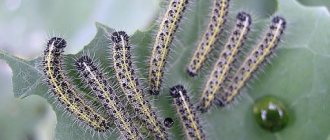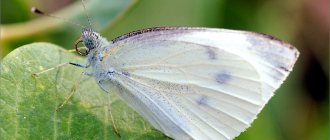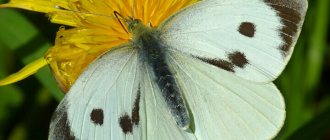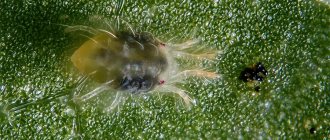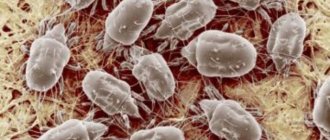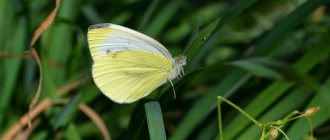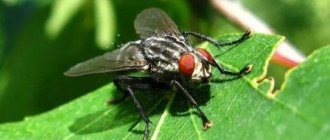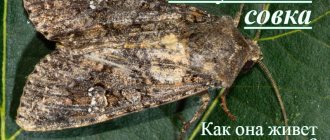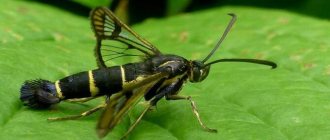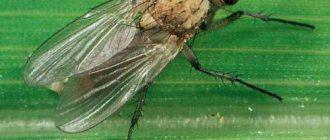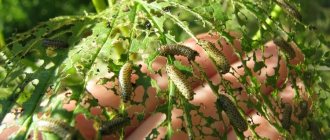Home / Pests and diseases
Back
Published: 04/22/2020
2
Rate this post
Plants of the cruciferous family are loved by many insects. The cabbage butterfly, the white butterfly, is no exception. It is distributed throughout the European part of Russia, Ukraine and other countries with a temperate climate. It is difficult to destroy cabbage caterpillars and butterflies, so it is better to ensure timely prevention.
- 1 Description
- 2 What it looks like at different stages of development
- 3 What is the danger
- 4 Control methods 4.1 Drugs
- 4.2 Folk remedies
Description
The photo fully reflects what cabbage whites look like. The insect is noticeable, large, its wingspan reaches 6 cm. The color is white, there are characteristic dark dots on the body that make the butterfly easily recognizable. A crescent-shaped spot is noticeable on the front wings. There is a certain feature - the insect is characterized by dimorphism: female whites are often larger than males.
The insect's flight begins in the spring; it is accustomed to a diurnal lifestyle. The greatest activity is observed in the hot summer. The cabbage plant does not tolerate windy weather and rain. Favorable temperature for reproduction is 22-25 degrees.
The process begins in July-August. The female lays eggs on plants, distributing them in small groups in different places. Fecundity is high, reaching 300 eggs in one approach.
Attention! The juice secreted by the larvae is poisonous. By eating them, small birds risk death. When collecting pests, a person must wear gloves, otherwise the skin may develop irritation, rashes and itching.
Varieties and characteristic features of cabbage whites
Stereotypically, all white butterflies are immediately perceived as pests, and gardeners immediately call them cabbage butterflies. In fact, in addition to the cabbage white, there are also its doubles that belong to the same genus.
Repnitsa. A butterfly similar to cabbage from the same family. She also has black spots on her wings (2 in the female, 1 in the male) and a black border on their upper corners. This insect differs from the cabbageweed in size - the reptile is smaller and its wingspan almost never exceeds 4 cm.
Rutgrass. The males of these butterflies are especially similar to cabbage whites, since the upper corners of their wings, like those of the cabbage whites, are black. The difference is that their border is less bright and can be gray or brownish-gray. The lower wing of the double is yellowish. Smaller sizes.
See also: Feeding cabbage and treating it against pests with ammonia
Hawthorn. This butterfly also resembles a cabbage pest. It is the same in size, but the color of its wings is slightly different. They are white, but not with spots, but with black streaks.
Pea whiteweed. A distinctive feature of this butterfly is that it always has light corners on its wings. This butterfly almost never visits gardens. The species is recognized as one of the rarest among whitefishes and is more often found in open meadows and clearings.
Neither of the lookalikes attacks cabbage beds, but also attacks plants that provide food for their larvae, as reflected in the name of each butterfly.
What it looks like at different stages of development
The eggs of the butterfly are pin-shaped, light yellow in color, and quite large - reaching 1.2 mm in length. After about 1-2 weeks, gray-green caterpillars emerge from them, with dark spots and stripes. The size depends on weather conditions and is 3.5 cm.
The larvae do not move at first. They attach to the underside of the leaf blade and feed on its pulp. After a few days, the caterpillars crawl across the cabbage and destroy its leaves, leaving deep furrows. Young insects eat the outside, while mature ones eat the inside.
The larval stage lasts 2-4 weeks. After this, the caterpillar can attach itself with a belt of threads to stones and trees, where it becomes a pupa. It has an angular shape and a bright yellow-green color. Black dots appear on the sides of the body and on the back. Pupae are often found on fences and trees, on the walls of buildings. In this phase they rarely remain on the leaves.
The pupal stage lasts about 2 weeks. If at this moment there is a cold snap or the weather is rainy, most likely the insect will complete its cycle after wintering.
The second generation appears if the first remains viable. This cycle of cabbage development is repeated annually. In the southern regions, 5 generations appear over the summer, in the middle zone - up to three.
Attention! Complete or incomplete transformation of pests is possible. In the second case (hemimetamorphosis), only 3 stages of development pass through: eggs, larvae, imago. This is not typical for cabbage. Whitefish undergo a complete transformation—holometamorphosis, which includes 4 stages: eggs, larvae, pupae, and imago.
Insects with incomplete metamorphosis
Development with incomplete transformation is characterized by the fact that an insect emerges from the egg shells, similar in structure to the adult, but much smaller in size. As a result of intensive nutrition, it grows, but the chitinized cover prevents an increase in linear dimensions and volume. This leads to molting, during which the chitinized cover, which has become tight, is shed. Beneath it there is a new soft cuticle lying in folds.
After shedding the old cover, the new cuticle straightens out. The size of the animal increases. After several molts without the formation of a pupa, the animal reaches maturity, its wings develop, the gonads mature, and the external genital appendages appear. This is how Orthoptera, lice, bugs, etc. develop.
Insects with incomplete transformation include representatives of the order Orthoptera: migratory locusts, grasshoppers, crickets. They have gnawing type mouthparts, their front wings are long, narrow and thickened, and their hind wings are wide and soft.
The hind legs of Orthoptera are very well developed and significantly longer than the front and middle legs; thanks to them, orthoptera make jumps over long distances.
The locust is a representative of insects with incomplete metamorphosis
Locusts reach a length of 5-6cm. She is very voracious and feeds on any plants. Constantly lives and reproduces in reed thickets. In the CIS, its habitats are the banks of the lower reaches of the Terek, Kuban, Ural, Amu Darya, and Syr Darya rivers. At the end of summer, the female locust lays eggs in the soil. They are glued together and form a so-called capsule.
In the spring, larvae emerge from the eggs, similar in structure to adult insects, but a number of organs, including wings, are still underdeveloped. Such larvae are called walking locusts. The larvae grow, molt, and develop into adult winged insects. Migratory locusts can fly long distances from their permanent habitats and cause enormous damage to crops. The main method of combating locusts is the use of various poisons.
What is the danger
Light-colored butterflies flying over cabbage are attracted not only to cruciferous plants. They are dangerous for the following garden crops:
- beets and rutabaga;
- radish;
- rape;
- horseradish;
- mignonette;
- nasturtium;
- mustard.
The whitefish does not disdain even plants that produce a lot of essential oils. Caterpillars can often be seen on garlic and onions.
Interesting! The butterfly received the name “cabbage plant” after active cultivation of various varieties of cruciferous vegetables began. Before this, the insect fed on radish and field mustard, and the genus was not so numerous.
Nutrition
Cabbage whiteweed eats cruciferous plants. Young caterpillars, being together for the first time, feed on the pulp from the lower part of the leaves, leaving the upper skin. Then the individuals spread throughout the plant. Cabbage grass begins to eat leaves mainly from the edges, adult caterpillars crawl to the upper surface. They gnaw the flesh, leaving only the rough veins. Butterflies prefer to fly during the daytime. They feed (except for the pulp of leaves) on plant nectar. Large concentrations of individuals can be found in areas protected from the wind and located near fences and tree plantations. In large areas sown with cabbage, the pest, as a rule, settles along the edges of the field.
The caterpillars cause damage to cabbage leaves, radishes, turnips, rutabaga and other crops. They can also feed on plants of other families, for example, nasturtium, mignonette, capers. In addition, secretions from the glands of the caterpillar's body provoke irritation on the human body. There have even been isolated cases of poisoning and death of birds that fed on these caterpillars. Cabbage whiteweed causes the greatest harm in the western and northwestern regions of Russia.
Fighting methods
If insect eggs are found on cabbage, measures should be taken immediately to ensure their destruction. The first thing the gardener must do is to carefully examine the plantings, find all the masonry, collect them and destroy them. This method is applicable and justified in compact summer cottages.
In large areas, chemicals will help save the crop. They can be used at the initial stage of the growing season. If processed late, there is a possibility of “poisoning” the vegetable; its consumption will be dangerous for humans. It is possible to save the plantings in this case, but the struggle will be long, because you will have to use safe methods with reduced effectiveness.
Drugs
The fight against white grass will be successful if the gardener uses modern means of protection - insecticides. Chemical and biological substances can be used. The advantage of the former is high efficiency. But there is a significant drawback - when cruciferous vegetables are processed at the head formation stage, they penetrate into the tissues of the plant and make it unsuitable for consumption.
Biological preparations are used at all stages of cultivation. The following remedies are effective:
- "Fitoverm";
- "Lepitotsid";
- "Akarin";
- "Gapsin";
- "Vertimek".
If the formation of cabbage forks has not yet begun, it is permissible to use chemicals. The following are recognized as the best in the fight against whiteweed:
- "Confidor";
- "Kinmiks";
- "Commander";
- "Aktellik";
- "Karbofos";
- "Bi-58".
The drugs must be diluted according to the standards indicated on the packaging. Exceeding the recommended proportions is dangerous for the plant, and reducing it will lead to ineffectiveness. The need for re-treatment (after 10-14 days), as recommended by the instructions, should not be ignored; it is needed to consolidate the result.
Attention! Chemicals are dangerous not only for the white butterfly, but also for humans. The gardener must take care of his health and take measures to prevent the substance from getting into the eyes, mucous membranes and skin.
Folk remedies
If the contamination is insignificant and the planting volume is small, you can do without the use of insecticidal preparations. Popular folk remedies are safe and economical, but are noticeably inferior in effectiveness to chemistry.
Tobacco dust (ash) will help remove cabbage from the beds; just sprinkle it on the leaf blades. They are also sprayed with saline and mustard solutions. To prepare 10 liters of the working mixture, use 100 g of the bulk component. The product is infused and filtered, and spraying is carried out in the evening or morning.
Cabbage whites disappear after treating the plantings with ammonia. To prepare the solution, pour a bottle (50 ml) of 3% ammonia into 10 liters of clean water. This mixture is prepared immediately before use, because the active substance evaporates quickly. The composition cannot be stored. The product also helps get rid of other garden pests.
Area
Cabbage whites are quite widespread throughout Eastern European territory. Representatives of the species can also be found in the temperate zone of Asia, in the eastern regions to Japan, as well as in North Africa. In 1993, the penetration of individuals into the territory of Southern Primorye was noted. Cabbage whites were introduced to Panama and Chile. In areas located north of the Arctic Circle, you can find mainly migrant individuals. The favorite places of representatives of the species are roadsides, forest edges, parks, gardens, clearings, forest belts along the railway track. Cabbage grass is also often found in populated areas where there are cultivated cruciferous plants. It should, however, be said that the geographic distribution of the butterfly is limited by temperature conditions. Thus, wintering pupae die at -20 degrees in fairly large numbers. The optimal temperature for the growth of individuals is considered to be 20-26 degrees above zero. In too hot a climate (more than 35-38 degrees), the development of cabbage whites slows down or it dies. The pest is very widespread throughout Russia, except, perhaps, in the regions of Siberia and the Far North. There, its presence and development is complicated by fairly low temperatures and harsh climatic conditions.
Prevention
Recommendations to prevent the destruction of crops by whiteweed:
- After the start of insect flight, the area is regularly inspected for the presence of wild cruciferous crops. They must be removed because they attract pests;
- in order to disorient insects, mulch the beds with repellent herbs (plants with a specific odor are used);
- Spray the plants with a solution of birch tar. The procedure is repeated at intervals of 2 weeks;
- The underside of the sheet is periodically inspected in order to identify the masonry in time.
If you follow the recommended sequence of treatments and regularly inspect the plantings, the likelihood of damage to cruciferous plants is reduced to zero. Ignoring the problem is dangerous because caterpillars reproduce quickly.
other methods
The reproduction and development of the butterfly is significantly hampered by various diseases. For example, a bacterial culture of wax moth is often used, which provokes illness and subsequent death of caterpillars. Flycheria is of particular importance among bacteriological pathologies. Caterpillars affected by it stop growing, become lemon-yellow in color and quickly die. Inside, the tissues of the infected individual turn to mush. One of the races of Trichogramma (egg eater) may also appear in white eggs.
One of the simplest methods for exterminating white butterflies is considered to be regular inspection of the lower surface of the leaves of cruciferous plants and crushing of the laid eggs. Manual collection of caterpillars and their destruction is used. In addition, quite a lot of insecticidal preparations are produced today. They are used to spray the future crop at the beginning of the season to prevent the appearance of pests, as well as at their first appearance to destroy young individuals. Treatment of plants prevents further growth of caterpillars and protects crop leaves from damage.
Type: Arthropods
Class: Insects
Order: Lepidoptera
Family: Belyanki
Genus: Garden whites
Type: Cabbage
What harm is done to a person?
Unlike the white butterfly, the larval form of insects is more dangerous. The caterpillar destroys plant shoots. First, the larvae live on the inside of the leaves, then move to the upper part. You can catch the cabbage butterfly caterpillar on cabbage, radish, and mustard. In addition, it is found on plants such as horseradish and turnips. This is the favorite food of such pests.
In addition to the harmful effects on vegetation, the larvae create other problems. Thus, they secrete special substances that irritate human skin. The white caterpillar is also dangerous for birds; birds often die when they eat it.
Nutrition
The second and third generations of insects become a real disaster for summer residents and gardeners. The first month of summer is the most favorable for breeding offspring of the cabbage butterfly.
The insect’s favorite food crops appear in the garden:
The pest most often leaves egg masses on the underside of the leaves of these vegetable crops. The emerging caterpillars begin to actively feed on juicy young leaves. First they eat the outer side, then move to the central part. By damaging the leaves of vegetable crops, the caterpillars disrupt the processes of photosynthesis in the plant, thereby causing irreparable damage to the future harvest. When the larvae eat the cabbage leaves down to the base, they move on to the inner leaves of the cabbage head. This leads to the destruction of the entire plant. An adult white moth does not damage vegetation.
Cabbage butterflies eat nectar and pollen of wildflowers:
Habitat
The cabbage butterfly lives throughout Eastern Europe, North Africa, East Asia and some regions of South America. It can be found on forest edges and clearings, in gardens and orchards where cruciferous vegetables grow - shepherd's purse, rapeseed, rapeseed, radish and various types of cabbage.
In search of food, butterflies make long flights over long distances. The ability to migrate, natural strength and adaptability to difficult conditions are characteristic of all representatives of the whitefish family. Some individuals of these insects living in the forests of Asia are distinguished by great endurance. The most beautiful and largest individuals of these tropical insects are born during the rainy season.
Ways to protect your garden from pests
An adult can live for 1-1.5 months, during which time the female lays a large number of eggs. You can try to prevent the emergence of new generations of insects.
To do this, a number of measures should be taken:
- Agrotechnical methods . It is assumed that cruciferous weeds need to be removed. The favorite food of the cabbage white butterfly is cress, shepherd's purse. You need to clean a large area: the entire area, the garden, since even a small amount of these types of weeds will help attract butterflies. Here is the best way to scare away the pest butterfly - sow dill after weeding. It grows quickly, does not shade vegetables and imparts the desired aroma.
- Mechanical removal . In this case, you need to collect the larvae yourself, examining the leaves of the plants from both sides. The task is labor-intensive, but you can try to influence the reproduction process by destroying the butterfly pupae. Identification features: color yellow-green, with dark splashes. Pupae are attached to fences, under the roof, in the crevices of old stumps, trees, and on the branches of bushes. In the spring, all buildings and trees are inspected. It is recommended to wash the possible attachment sites of the pupae with a powerful stream of water from a hose. It will not be possible to completely destroy insects in this way, but their numbers can be greatly reduced.
- Chemical . To destroy cabbage weeds, products based on insecticides of different classes are suitable: neonicotinoids, pyrethroids, organophosphorus compounds.
- Biological drugs . Not as harmful as chemicals, so they are used more often. The main options: Lepidocid, Fitoverm, Bitoxibacillin. Chemical-based preparations, as well as biological pesticides, are recommended to be sprayed during the growing season. An additional measure is whitewashing tree trunks. Cabbage grass's favorite foods (radish, cabbage, radishes, turnips, etc.) are planted at some distance from each other. Marigolds, garlic, dill, valerian, parsley, carrots and lemon balm will help repel insects.
Doll
What does a cabbage butterfly look like in the pupal stage? The color is almost the same as that of the butterfly - yellowish-green with black splashes. When transitioning to the pupal stage, the larva is wrapped in threads somewhat reminiscent of silk, and with them it clings to plants. If the folding into a chrysalis did not occur too late, then a butterfly will soon be born. If the atmospheric temperature does not allow the transformation to occur, then the insect enters the diapause stage and overwinters. With the onset of spring, such insects begin their first generation.
For information, diapause is the process of inhibition of physiological processes in an insect with a transition to the stage of suspended animation. The insect remains in this stage for several weeks. During this period, the pupa molts several times, and this process is called complete metamorphosis.

